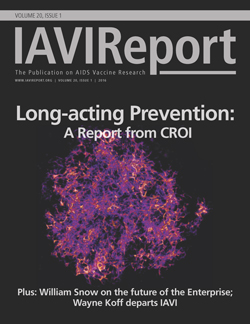IAVI REPORT – VOL. 20, NO. 1, 2016

It was 20 years ago this summer that the first issue of IAVI Reportwas published. That was the same year that IAVI was founded as a product development partnership with an aim to expedite development of an HIV vaccine that was relevant in the parts of the world that were most affected by HIV/AIDS.
In IAVI Report’s inaugural issue, Margaret Johnston, the then scientific director of IAVI, outlined the reasons why an HIV vaccine is scientifically possible. She concluded the list by saying this: “A slight but real sense of optimism is beginning to emerge in the effort to develop an AIDS vaccine.” What is striking about this is that this captures precisely the sentiment that exists in vaccine research today. After many setbacks and discouraging results, researchers have gained a tremendous amount of knowledge about how the virus interacts with the immune system and how to design better HIV vaccine candidates.
It is also striking that in this issue we bid farewell to the person who replaced Johnston 17 years ago. Wayne Koff, who is only the second person in IAVI’s history to lead the research and development effort, left his full-time role as Chief Science Officer at IAVI in March to take on a new role as President of the Human Vaccines Project. We pay tribute to Koff and his role in shaping HIV vaccine science, including establishing the Neutralizing Antibody Consortium, overseeing the Protocol studies that led to the isolation of scores of new broadly neutralizing antibodies against HIV, and the implementation of first-rate clinical research centers in Africa and India that are poised to contribute to the development of an HIV vaccine.
In this issue we also discuss the future of HIV vaccine development and the Global HIV Vaccine Enterprise with Bill Snow, executive director of the Enterprise and a long-time vaccine advocate.
Finally, we bring you a full report on the latest news in HIV prevention from this year’s Conference on Retroviruses and Opportunistic Infections (CROI), which took place in February in Boston. Results from efficacy studies of a vaginal ring containing an experimental antiretroviral were reported and discussed extensively at CROI, as well as updates on the uptake of oral pre-exposure prophylaxis and emerging data on long-active antiretrovirals that may have both therapeutic and preventive roles in the future.
Now, we ask for your opinion. As IAVI Report kicks off its 20th year, we’d like to ask our loyal readers to provide some feedback on the publication and its value so we can ensure it continues to meet the needs of our audience. To do so, please take a very brief survey online. We hope you will take the time to share you opinions with us.
—Kristen Jill Kresge


